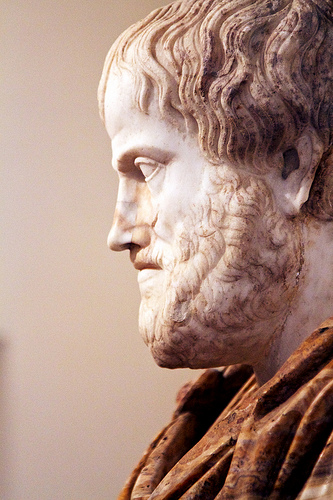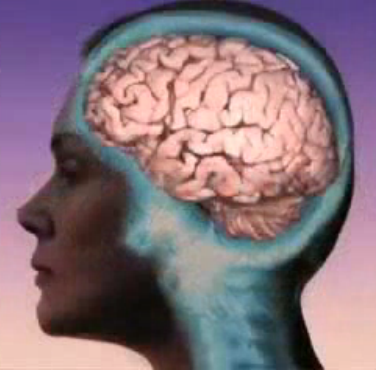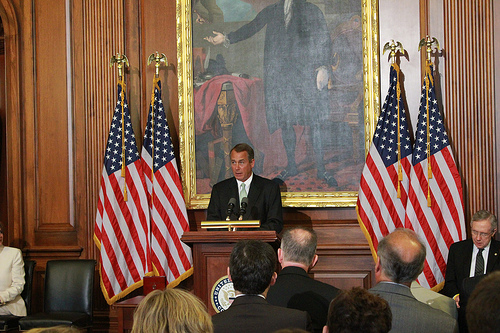
Source: Aristotle, Nick in exsilio, Flickr
In the previous section of the lesson, you saw that famous speeches are written about a certain subject and that speeches are composed with an audience (or audiences) in mind. You also articulated the speaker’s purpose and thought about what the speaker wants you (the audience) to feel while listening to a speech or to do after listening to the speech.
To be persuasive, the speaker must take the audience into consideration and appeal to them in ways that will convince them. The Greek philosopher Aristotle (384 BC–322 BC) described three appeals that can be used to persuade an audience: ethos, pathos, and logos.
Study the chart below to learn the distinctions among these three appeals.
LOGOS

Source: Human brain female side view, National Institute of health, Wikimedia
The speaker appeals to the audience’s sense of reason, using logic, facts, and statistics.
ETHOS

Source: House Speaker John Boehner, R-Ohio, talk radio News Service, Flickr
The speaker tries to show the audience that he or she is reliable, credible, and trustworthy. The speaker also tries to build a bridge to the audience by using first-person plural pronouns (we, us).
PATHOS

Source: Valentine Mosaic, Auntie K, Flickr
The speaker appeals to the audience’s emotions, using emotional language, sensory images, and anecdotes.
Now, read how former First Lady and Secretary of State Hillary Rodham Clinton uses logos, ethos, and pathos in the following quotations from a speech delivered to the fourth World Conference of the United Nations. Clinton speaks about the rights of women around the world.
LOGOS
“Women comprise more than half the world’s population, 70% of the world’s poor, and two-thirds of those who are not taught to read and write.”
“If women are healthy and educated, their families will flourish. If women have a chance to work and earn as full and equal partners in society, their families will flourish.”
ETHOS
“Over the past 25 years, I have worked persistently on issues relating to women, children, and families.”
“Earlier today, I participated in a World Health Organization forum.”
“I have met mothers in Indonesia. I have met working parents in Denmark. I have met women in South Africa.”
PATHOS
“Women also are dying from diseases that should have been prevented or treated. They are watching their children succumb to malnutrition caused by poverty. They are being denied the right to go to school by their own fathers and brothers. They are being forced into prostitution, and . . . banned from the ballot box.”

Source: Hillary Clinton Speaking at UN, State department
video, screenshot IPSI
Clinton appeals to logos with statistics (“more than half,” “70%,” “two-thirds”) to persuade her audience of the importance of her cause: worldwide human rights for women. She also poses a logical cause-and-effect argument (“If women . . ., then . . .”).
Clinton establishes her ethos, or credibility, when she cites her 25 years of experience working on “issues relating to women,” her participation in the World Health Organization forum, and the women she has met in her travels around the world.
Think of pathos as a “path” to the audience’s heart. Clinton taps into the audience’s sympathy by listing hardships women face around the world (poverty, malnutrition). She also cites examples of rights that women are denied in some parts of the world (education, voting).
Now, read the excerpts from famous speeches below. Match each excerpt to the speaker’s primary means of persuasion. You will use one choice more than once. A brief description of the speaker and the occasion is provided below each excerpt.

 Did you notice as you were reading the previous quotations that the appeals sometimes seem to overlap? Look at Chief Joseph’s quotation again. What do you see in addition to pathos? Write your answer and reasons to support it using your notes. When you’re finished, check your understanding to see a possible response.
Did you notice as you were reading the previous quotations that the appeals sometimes seem to overlap? Look at Chief Joseph’s quotation again. What do you see in addition to pathos? Write your answer and reasons to support it using your notes. When you’re finished, check your understanding to see a possible response.
Tell General Howard I know his heart. What he told me before, I have it in my heart. I am tired of fighting. Our Chiefs are killed; Looking Glass is dead, Toohulhulsote is dead. The old men are all dead. It is the young men who say yes or no. He who led on the young men is dead. It is cold, and we have no blankets; the little children are freezing to death. My people, some of them, have run away to the hills, and have no blankets, no food. No one knows where they are—perhaps freezing to death. I want to have time to look for my children, and see how many of them I can find. Maybe I shall find them among the dead. Hear me, my Chiefs! I am tired; my heart is sick and sad. From where the sun now stands I will fight no more forever.
—Chief Joseph of the Nez Perce on his surrender to the U.S. Army in 1877
Sample Response:
Chief Joseph uses ethos. In an attempt to persuade his fellow chiefs to give up fighting, he tries to establish himself as having the best interests of his people in mind. He refers to “my people” and assumes the responsibility of finding as many of them as possible.

Source: Lindos113, Piotrus, Wikimedia
Aristotle considered the three appeals the pillars of rhetoric. When listening to or reading speeches, remember that these appeals might be used as follows:
- An appeal to logos can be effective because it sends a message to the audience’s brain.
- An appeal to ethos can be persuasive because it conveys the credibility of the speaker.
- An appeal to pathos can be convincing because it sends a message to the audience’s heart.